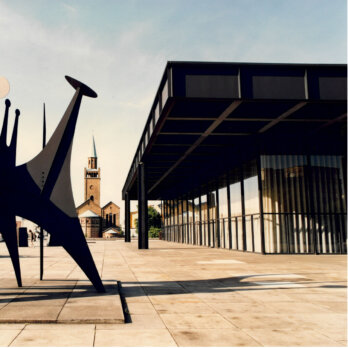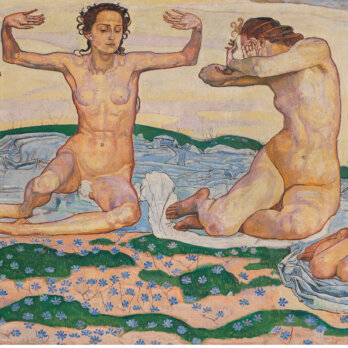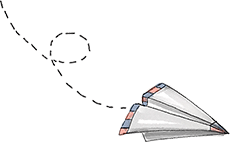Opening Times
Tuesday + Wednesday 10-18 h
Thursday 10-20 h
Friday 10-18 h
Saturday + Sunday 11-18 h
Address
Hamburger Bahnhof
Invalidenstraße 50-51
10557 Berlin-Mitte
.How to get there
Contact
Our series on Berlin art institutions continues in July with the Hamburger Bahnhof . Find out why you should definitely visit it before the end of September this year and what Beuys has to do with the Anthropocene here.
First things first: the name already suggests that the building was not originally erected with the intention of showing art. Since 1846, today's Museum of Contemporary Art was the last station on the route between Berlin and Hamburg and is thus also the last remaining historic station in Berlin. After extensive renovations, it reopened as a museum in 1996.
That was quite a fine thing for the reunited Berlin. But it was the permanent loan of the Friedrich Christian Flick Collection that brought Hamburger Bahnhof global attention and necessitated an extensive expansion of the museum in 2004 (by connecting the historic building with the adjoining halls, thus increasing the exhibition space from 7,000 to more than 10,000 square metres).
From then on, the Hamburger Bahnhof, as part of the National Gallery, housed one of the world's largest and most important public collections of contemporary art. But that will come to an end this year. On 30 September 2021, to be precise!
How can that be? On this date, after seventeen successful years, the loan contract for the works from the Flick Collection will expire. The reason for this is truly hair-raising and the outcry in the capital was correspondingly great in 2020. The rental contract for the adjoining and beautiful halls (Rieckhallen) ends - because these halls, in which the Flick Collection has been shown up to now, will be demolished!
In other words: with these rooms, the Hamburger Bahnhof will also lose the works presented there. Berlin's cultural policy has failed all along the line, they had neglected to secure the premises in time, Flick's collection is going back to Switzerland...
Back to Beuys. The Rhineland-born artist, who is one of the most important artists of the 20th century worldwide, would have turned 100 this year. The Hamburger Bahnhof is dedicating the exhibition "From Language. Joseph Beuys on the occasion of his 100th birthday" - the starting point is a speech Beuys gave at the Münchner Kammerspiele in 1985 to the series "Reden über das eigene Land: Deutschland" (Speeches about one's own country: Germany).
In this speech he stated that he developed his works "from language". Equal to pictorial means of design, he understood language as a plastic material through which each and every individual could participate physically, intellectually and communicatively in the reorganisation of society."
While it is undeniably the case that we are all participating communicatively and "intellectually" in society more than ever before, Beuys probably did not imagine that most of this language now pours out on social media channels in hate comments, shitstorms, mercilessly hedonistic self-promotion, cat pictures and memes (bless them memes). We'll mercifully leave out the emojis and abbreviations here.
We realise that this actually fits quite well into the Anthropocene. That is, the age in which humans have become one of the most important (and that is truly not a compliment) influencing factors on the biological, geological and atmospheric processes on Earth. For all those who still prefer to deny it, it can be summarised in one sentence: Global warming caused by the greenhouse effect is considered the greatest challenge for mankind, or what remains of it in the next few decades.
Ironically, "Scratching the Surface", a group exhibition (with works from the collection of the National Gallery, the Friedrich Christian Flick Collection in the Hamburger Bahnhof and loans) is currently running in the Hamburger Bahnhof, which is dedicated to the Anthropocene of all things. It's about climate change, species extinction, overexploitation of resources and the proliferation of plastics (latest science: pollution by chemicals and plastics threatens to create a barren world by 2045) and how the understanding of landscape and environment has changed over the past six decades.
Beuys would probably have dwelled extensively on the word Anthropocene, for two reasons. First, he was a founding member of the Green Party, and second, he "challenged his fellow artists (which we all are*) to find an alternative to the two-bloc system, because communism turned out to be oppressive and capitalism, with its constant need for growth, cannot work in the long run because the planet on which it is practised is finite.... "
"We have to find that third way or we will perish and it takes the creativity of an artist to develop that concept."
*From Joseph Beuys' perspective, "Every human being is an artist" means that everyone contributes to the "social sculpture" and thus has responsibility for shaping our society. The "social sculpture" maps our society and our life on this planet.
Oh yes, the word Anthropocene comes from the ancient Greek and consists of the words ánthropos, in English 'human' and καινός meaning 'new'...












